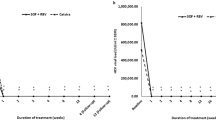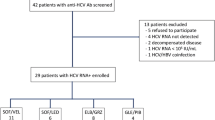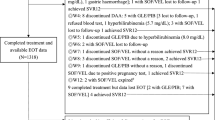Abstract
Pegylated interferon α (peginterferon α) plus ribavirin is the current mainstay of treatment for patients with chronic HCV infection. When peginterferon α plus ribavirin is administered for the standard duration, a sustained virological response is achieved in around 50% of patients infected with HCV genotype 1 and around 80% of patients infected with HCV genotype 2 or 3. Data now suggest that treatment duration can be shortened or lengthened depending on baseline viral load and/or early on-treatment viral kinetics, offering the prospect of individualizing therapy further to improve response or to prevent treatment from being unnecessarily extended. Further efforts to optimize therapy are likely to involve the use of new anti-HCV agents, several of which are currently in the early stages of development. These agents include HCV protease inhibitors (particularly those against NS3-4A protease), HCV polymerase inhibitors (including both nucleoside and non-nucleoside analogs) and cyclophilin inhibitors. These compounds will be used, at least initially, in combination with peginterferon α plus ribavirin, extending the pivotal role of interferon-based therapy in the management of chronic hepatitis C.
Key Points
-
The standard of care for chronic hepatitis C—peginterferon α plus ribavirin—results in a sustained virological response rate of around 50% amongst patients with HCV genotype 1 infection and around 80% in those with HCV genotype 2 or 3 infection, when administered for standard treatment durations
-
Treatment duration can be shortened or lengthened depending on baseline viral load and/or early on-treatment viral kinetics, offering the prospect of individualizing therapy to improve response or reduce unnecessarily extended treatment
-
Further improvement in the future will come through other anti-HCV drugs currently in development that will be used, at least initially, in combination with peginterferon α and ribavirin
This is a preview of subscription content, access via your institution
Access options
Subscribe to this journal
Receive 12 print issues and online access
$209.00 per year
only $17.42 per issue
Buy this article
- Purchase on Springer Link
- Instant access to full article PDF
Prices may be subject to local taxes which are calculated during checkout





Similar content being viewed by others
References
Hoofnagle JH et al. (1986) Treatment of chronic non-A, non-B hepatitis with recombinant human alpha interferon: a preliminary report. N Engl J Med 315: 1575–1578
[No authors listed] (2002) NIH Consensus Statement on Management of Hepatitis C: 2002. NIH Consens State Sci Statements 19: 1–46
Strader DB et al. for the American Association for the Study of Liver Diseases (2004) Diagnosis, management, and treatment of hepatitis C. Hepatology 39: 1147–1171
Yee HS et al. (2006) Management and treatment of hepatitis C viral infection: recommendations from the Department of Veterans Affairs Hepatitis C Resource Center program and the National Hepatitis C Program office. Am J Gastroenterol 101: 2360–2378
Farrell GC (2007) New hepatitis C guidelines for the Asia-Pacific region: APASL consensus statements on the diagnosis, management and treatment of hepatitis C virus infection. J Gastroenterol Hepatol 22: 607–610
Swain M et al. (2007) Sustained virologic response resulting from treatment with peginterferon alfa-2a alone or in combination with ribavirin is durable and constitutes a cure: an ongoing 5-year follow-up [abstract]. Gastroenterology 132 (Suppl 1): 741A
Veldt BJ et al. (2007) Sustained virologic response and clinical outcomes in patients with chronic hepatitis C and advanced fibrosis. Ann Intern Med 147: 677–684
Manns MP et al. (2007) The way forward in HCV treatment—finding the right path. Nat Rev Drug Discov 6: 991–1000
Chevaliez S and Pawlotsky JM (2007) Interferon-based therapy of hepatitis C. Adv Drug Deliv Rev 59: 1222–1241
Perelson AS et al. (2005) New kinetic models for the hepatitis C virus. Hepatology 42: 749–754
Herrmann E et al. (2000) Hepatitis C virus kinetics. Antivir Ther 5: 85–90
Fried MW et al. (2002) Peginterferon alpha-2a plus ribavirin for chronic hepatitis C virus infection. N Engl J Med 347: 975–982
Poordad F et al. (2008) Rapid virologic response: a new milestone in the management of chronic hepatitis C. Clin Infect Dis 46: 78–84
Nguyen MH et al. (2008) Higher rate of sustained virologic response in chronic hepatitis C genotype 6 treated with 48 weeks versus 24 weeks of peginterferon plus ribavirin. Am J Gastroenterol 103: 1131–1135
Kamal SM and Nasser IA (2008) Hepatitis C genotype 4: what we know and what we don't yet know. Hepatology 47: 1371–1383
PEGASYS® European SPC [http://emc.medicines.org.uk/emc/assets/c/html/displayDocPrinterFriendly.asp? documentid=10081]
PEGINTRON® European SPC [http://www.emea.europa.eu/humandocs/PDFs/EPAR/Pegintron/ H-280-PI-en.pdf]
Zeuzem S et al. (2005) International, multicenter, randomized, controlled study comparing dynamically individualized versus standard treatment in patients with chronic hepatitis C. J Hepatol 43: 250–257
Mihm U et al. (2006) Review article: predicting response in hepatitis C virus therapy. Aliment Pharmacol Ther 23: 1043–1010
Poynard T et al. (1998) Randomised trial of interferon alpha2b plus ribavirin for 48 weeks or for 24 weeks versus interferon alpha2b plus placebo for 48 weeks for treatment of chronic infection with hepatitis C virus. Lancet 352: 1426–1432
Zeuzem S et al. (2006) Efficacy of 24 weeks treatment with peginterferon alfa-2b plus ribavirin in patients with chronic hepatitis C infected with genotype 1 and low pretreatment viremia. J Hepatol 44: 97–103
Jensen DM et al. (2006) Early identification of HCV genotype 1 patients responding to 24 weeks peginterferon alpha-2a (40 kd)/ribavirin therapy. Hepatology 43: 954–960
Yu ML et al. (2008) Rapid virological response and treatment duration for chronic hepatitis C genotype 1 patients: a randomized trial. Hepatology 47: 1884–1893
Kamal SM et al. (2007) Pegylated interferon alpha-2b plus ribavirin in patients with genotype 4 chronic hepatitis C: the role of rapid and early virological response. Hepatology 46: 1732–1740
Mangia A et al. (2005) Peginterferon alfa-2b and ribavirin for 12 vs. 24 weeks in HCV genotype 2 or 3. N Engl J Med 352: 2609–2617
Dalgard O et al. (2004) Treatment with pegylated interferon and ribavirin in HCV infection with genotype 2 or 3 for 14 weeks: a pilot study. Hepatology 40: 1260–1265
von Wagner M et al. (2005) Peginterferon-alpha-2a (40 KD) and ribavirin for 16 or 24 weeks in patients with genotype 2 or 3 chronic hepatitis C. Gastroenterology 129: 522–527
Yu ML et al. (2007) A randomised study of peginterferon and ribavirin for 16 versus 24 weeks in patients with genotype 2 chronic hepatitis C. Gut 56: 553–559
Shiffman ML et al. for the ACCELERATE Investigators (2007) Peginterferon alfa-2a and ribavirin for 16 or 24 weeks in HCV genotype 2 or 3. N Engl J Med 357: 124–134
Dalgard O et al. (2008) Pegylated interferon alfa and ribavirin for 14 versus 24 weeks in patients with hepatitis C virus genotype 2 or 3 and rapid virological response. Hepatology 47: 35–42
Berg T et al. (2006) Extended treatment duration for hepatitis C virus type 1: comparing 48 versus 72 weeks of peginterferon-alfa-2a plus ribavirin. Gastroenterology 130: 1086–1097
Sánchez-Tapias JM et al. for the TeraViC-4 Study Group (2006) Peginterferon-alfa2a plus ribavirin for 48 versus 72 weeks in patients with detectable hepatitis C virus RNA at week 4 of treatment. Gastroenterology 131: 451–460
Pearlman BL et al. (2007) Treatment extension to 72 weeks of peginterferon and ribavirin in hepatitis C genotype 1-infected slow responders. Hepatology 46: 1688–1694
Mangia A et al. (2008) Individualized treatment duration for hepatitis C genotype 1 patients: a randomized controlled trial. Hepatology 47: 43–50
Ferenci P et al. (2006) Customizing treatment with peginterferon alfa-2a (40 KD) (PEGASYS®) plus ribavirin (COPEGUS®) in patients with HCV genotype 1 or 4 infection: interim results of a prospective randomized trial [abstract #390]. Hepatology 44 (Suppl 1): 336A
Sánchez-Tapias JM et al. (2007) Which HCV genotype 1 patients may benefit from extended treatment with peginterferon alfa-2a (40KD) (PEGASYS®) plus ribavirin (COPEGUS®)? [abstract #0-196]. Hepatol Int 1: 36
Zeuzem S (2004) Heterogeneous virologic response rates to interferon-based therapy in patients with chronic hepatitis C: who responds less well? Ann Intern Med 140: 370–381
Willems B et al. (2007) Should treatment with peginterferon plus ribavirin be intensified in patients with HCV genotype 2/3 without a rapid virologic response? [abstract #8] J Hepatol 46 (Suppl 1): S6
Hadziyannis SJ et al. for the PEGASYS International Study Group (2004) Peginterferon-alpha2a and ribavirin combination therapy in chronic hepatitis C: a randomized study of treatment duration and ribavirin dose. Ann Intern Med 140: 346–355
Shiffman ML et al. for the Hepatitis C Antiviral Long-Term Treatment Against Cirrhosis Trial Group (2004) Peginterferon alfa-2a and ribavirin in patients with chronic hepatitis C who have failed prior treatment. Gastroenterology 126: 1015–1023
Poynard T et al. (2006) HCV negativity after 12 weeks of therapy is the best predictor of sustained virological response (SVR) in the re-treatment of previous interferon/ribavirin non-responders: results from the EPIC3 program [abstract #1123]. Hepatology 44 (Suppl 1): 607A
Jensen DM et al. (2007) Pegylated interferon alfa-2a (40KD) plus ribavirin (RBV) in prior non-responders to pegylated interferon alfa-2b (12KD)/RBV: final efficacy and safety outcomes of the REPEAT study [abstract #LB4]. Hepatology 46 (Suppl 1): 291A
Lindahl K et al. (2005) High-dose ribavirin in combination with standard dose peginterferon for treatment of patients with chronic hepatitis C. Hepatology 41: 275–279
Di Bisceglie A et al. (2007) Prolonged antiviral therapy with peginterferon to prevent complications of advanced liver disease associated with hepatitis C: results of the hepatitis C antiviral long-term treatment against cirrhosis (HALT-C) trial [abstract #LB1]. Hepatology 46 (Suppl 1): 290A
Afdhal NH et al. (2008) Colchicine versus peg-interferon alpha 2b long term therapy: results of the 4 year COPILOT trial [abstract #3]. J Hepatol 48 (Suppl 2): S4
Hinrichsen H et al. (2004) Short-term antiviral efficacy of BILN 2061, a hepatitis C virus serine protease inhibitor, in hepatitis C genotype 1 patients. Gastroenterology 127: 1347–1355
Reesink HW et al. (2006) Rapid decline of viral RNA in hepatitis C patients treated with VX-950: a phase Ib, placebo-controlled, randomized study. Gastroenterology 131: 997–1002
Sarrazin C et al. (2007) SCH 503034, a novel hepatitis C virus protease inhibitor, plus pegylated interferon alpha-2b for genotype 1 nonresponders. Gastroenterology 132: 1270–1278
Sarrazin C et al. (2007) Dynamic hepatitis C virus genotypic and phenotypic changes in patients treated with the protease inhibitor telaprevir. Gastroenterology 132: 1767–1777
Jacobson IM et al. (2007) Interim analysis results from a phase 2 study of telaprevir with peginterferon alfa-2a and ribavirin in treatment-naive subjects with hepatitis C [abstract #177]. Hepatology 46 (Suppl 1): 315A–316A
Hezode C et al. (2007) PROVE2: phase II study of VX950 (telaprevir) in combination with peginterferon alfa 2a with or without ribavirin in subjects with chronic hepatitis C, first interim analysis [abstract #80]. Hepatology 46 (Suppl 1): 268A
McHutchison JG et al. (2008) PROVE1: results from a phase 2 study of telaprevir with peginterferon alpha-2a and ribavarin in treatment-naïve subjects with hepatitis C [abstract #4]. J Hepatol 48 (Suppl 2): S4
Dusheiko GM et al. (2008) Treatment of chronic hepatitis C with telaprevir (TVR) in combination with peginterferon-alpha-2a with or without ribavarin: further interim analysis results of the PROVE2 study [abstract #58]. J Hepatol 48 (Suppl 2): S26
Susser S et al. (2008) Clonal analysis of mutations selected in the HCV NS3 protease domain of genotype 1 non-responders treated with beceprevir (SCH503034) [abstract #65]. J Hepatol 48 (Suppl 2): S29
Schiff E et al. (2008) Boceprevir (B) combination therapy in null responders (NR): response dependent on interferon responsiveness [abstract #104]. J Hepatol 48 (Suppl 2): S46
Kwo P et al. (2008) Interim results from HCV SPRINT-1: RVR/EVR from phase 2 study of boceprevir plus PegIntron™ (peginterferon alpha-2b)/ribavirin in treatment-naïve subjects with genotype-1 CHC [abstract #995]. J Hepatol 48 (Suppl 2): S372
Zhou XJ et al. (2005) Pharmacokinetics and pharmacodynamics of valopicitabine (NM283), a new nucleoside HCV polymerase inhibitor: results from a phase I/II dose-escalation trial in patients with HCV-1 infection [abstract #626]. J Hepatol 42 (Suppl 2): 229A
Lawitz E et al. (2007) Clearance of HCV RNA with valopicitabine (NM283) plus peg-interferon in treatment-naive patients with HCV-1 infection: results at 24 and 48 weeks [abstract #14]. J Hepatol 46 (Suppl 1): 9A
Roberts SK et al. (2008) Robust antiviral activity of R1626, a novel nucleoside analog: a randomized, placebo-controlled study in patients with chronic hepatitis C. Hepatology 48: 398–406
Pockros PJ et al. (2008) R1626 plus peginterferon alfa-2a provides potent suppression of hepatitis C virus RNA and significant antiviral synergy in combination with ribavirin. Hepatology 48: 385–397
Le Pogam S et al. (2007) A high barrier to resistance may contribute to the robust antiviral effect demonstrated by R1626 in HCV genotype 1-infected treatment-naive patients [abstract #1298]. Hepatology 46 (Suppl 1): 813A
Reddy R et al. (2007) Antiviral activity, pharmacokinetics, safety, and tolerability of R7128, a novel nucleoside HCV RNA polymerase inhibitor, following multiple, ascending, oral doses in patients with HCV genotype 1 infection who have failed prior interferon therapy [abstract # LB9]. Hepatology 46 (Suppl 1): 862A–863A
Lalezari J et al. (2008) Potent antiviral activity of the HCV nucleoside polymerase inhibitor R7128 with PEG-IFN and ribavirin: interim results of R7128 500mg bid for 28 days [abstract #66]. J Hepatol 48 (Suppl 2): S29
Villano S et al. (2007) Antiviral activity of the non-nucleoside polymerase inhibitor, HCV-796, in combination with pegylated interferon alfa-2b in treatment naive patients with chronic HCV [abstract #50]. J Hepatol 46 (Suppl 1): S24
Bavisotto et al. (2007) Antiviral, pharmacokinetic and safety data for GS-9190, a non-nucleoside HCV NS5B polymerase inhibitor, in a phase 1 trial in HCV genotype 1 infected subjects [abstract #49]. Hepatology 46 (Suppl 1): 255A
Cooper C et al. (2007) Antiviral activity of the non-nucleoside polymerase inhibitor, VCH-759, in chronic hepatitis C patients: results form a randomized, doubleblind, placebo-controlled, ascending multiple dose study [abstract #844]. Hepatology 46 (Suppl 1): 864A
Nicolas O et al. (2008) Genotypic analysis of HCV NS5B variants selected form patients treated with VCH-759 [abstract #LB11]. J Hepatol 48 (Suppl 2): S317
Flisiak R et al. (2008) The cyclophilin inhibitor Debio-025 shows potent anti-hepatitis C effect in patients coinfected with hepatitis C and human immunodeficiency virus. Hepatology 47: 817–826
Kaita K et al. (2007) PhII proof of concept study of celgosivir in combination with peginterferon alfa-2b and ribavirin in chronic hepatitis C genotype-1 non-responder patients [abstract #127]. J Hepatol 46 (Suppl 1): S56–S57
Rossignol JF et al. (2007) Interim data from a randomized controlled trial of nitazoxanide-peginterferon-ribavirin, nitazoxanide-peginterferon and peginterferon-ribavirin in the treatment of patients with chronic hepatitis C genotype 4 [abstract #178]. Hepatology 46 (Suppl 1): 316A
Standring D et al. (2007) HCV polymerase (NM107) and protease (boceprevir) inhibitors in combination show enhanced activity and suppression of resistance in the replicon system [abstract #1391]. Hepatology 46 (Suppl 1): 857A
Grunberger C et al. (2008) 3-Drug synergistic interactions of small molecular inhibitors of hepatitis C virus replication. J Infect Dis 197: 42–45
Lawitz E et al. (2008) Antiviral effects and safety of telaprevir, peginterferon alfa-2a, and ribavirin for 28 days in hepatitis C patients. J Hepatol 49: 163–169
Acknowledgements
Charles P Vega, University of California, Irvine, CA, is the author of and is solely responsible for the content of the learning objectives, questions and answers of the Medscape-accredited continuing medical education activity associated with this article.
Author information
Authors and Affiliations
Ethics declarations
Competing interests
Stefan Zeuzem is a clinical investigator and consultant for Debiopharm, Gilead, Human Genome Sciences, Intermune, Novartis, Pharmasset, Roche, Schering-Plough, Tibotec, Vertex, and Wyeth.
Rights and permissions
About this article
Cite this article
Zeuzem, S. Interferon-based therapy for chronic hepatitis C: current and future perspectives. Nat Rev Gastroenterol Hepatol 5, 610–622 (2008). https://doi.org/10.1038/ncpgasthep1274
Received:
Accepted:
Published:
Issue Date:
DOI: https://doi.org/10.1038/ncpgasthep1274
This article is cited by
-
Computational Study of HCV p7 Channel: Insight into a New Strategy for HCV Inhibitor Design
Interdisciplinary Sciences: Computational Life Sciences (2019)
-
Improvements in brain and behavior following eradication of hepatitis C
Journal of NeuroVirology (2017)
-
Using anti-poly(ethylene glycol) bioparticles for the quantitation of PEGylated nanoparticles
Scientific Reports (2016)
-
Incidence and cost of treatment-emergent comorbid events in insured patients with chronic hepatitis C virus infection: a retrospective cohort study
BMC Health Services Research (2014)
-
Future therapies for chronic hepatitis C
Nature Reviews Gastroenterology & Hepatology (2013)



